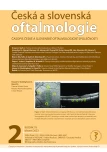SEVERE NEAR REFLEX SPASM IN A HEALTHY TEENAGER. A CASE REPORT
Autoři:
G. Mejía 1,2; S. Guevara 2; Y. Salgado 2; A. Tello 3,4,5
Působiště autorů:
Neuroscience Research Group (NEUROS). Neurovitae Research Center. School of Medicine and Health Sciences. Rosario University, Bogotá, Colombia
1; Ophthalmology Interest Group Universidad del Rosario. (OIG UR). School of Medicine and Health Sciences. Rosario University, Bogotá, Colombia
2; Virgilio Galvis Eye Center, Floridablanca, Colombia
3; Ophthalmology Foundation of Santander - Carlos Ardila Lulle (FOSCAL), Floridablanca, Colombia
4; Ophthalmology Foundation of Santander, Industrial University of Santander (UIS), Bucaramanga, Colombia
5
Vyšlo v časopise:
Čes. a slov. Oftal., 79, 2023, No. 2, p. 97-100
Kategorie:
Kazuistika
doi:
https://doi.org/10.31348/2023/15
Souhrn
Introduction: Spasm of the near reflex usually includes accommodative spasm, esophoria/tropia, and different degrees of miosis. Patients usually refer to distance blurred and fluctuating vision, ocular discomfort, and headaches. The diagnosis is established with refraction with and without cycloplegia; most of the cases have a functional etiology. However, some cases require neurological conditions to be ruled out; cycloplegics have an important diagnostic and therapeutic role.
Purpose: To describe a case of bilateral severe accommodative spasm in a healthy 14-year-old teenager.
Case presentation: A 14-year-old boy with progressive diminished visual acuity attended for YSP consultation. The diagnosis of bilateral spasm of the near reflex was made, based on a gap refraction of 9.75 D between retinoscopy with and without cycloplegia and esophoria with normal keratometry and axial length. The spasm was eliminated with 2 drops of cycloplegic in each eye separated by 15 days; no clear etiology was found other than the start of school.
Conclusion: Clinicians should be aware of pseudomyopia, especially in children with acute changes in visual acuity, who are usually exposed to myopigenic environmental factors that induce overstimulation of the parasympathetic third cranial nerve’s innervation.
Zdroje
1. Goldstein JH, Schneekloth BB. Spasm of the near reflex: A spectrum of anomalies. Surv Ophthalmol. 1996;40(4):269-278.
2. García-Montero M, Felipe-Márquez G, Arriola-Villalobos P, Garzón N. Pseudomyopia: A Review. Vision. 2022;6(1):17.
3. London R, Wick B, Kirschen D. Post-traumatic pseudomyopia. Optom St Louis Mo. 2003;74(2):111-220.
4. Kowal L. Ophthalmic manifestations of head injury. Aust N Z J Ophthalmol. 1992;20(1):35-40.
5. Hyndman J. Spasm of the Near Reflex: Literature Review and Proposed Management Strategy. J Binocul Vis Ocul Motil. 2018;68(3):78-86.
6. Papageorgiou E, Kardaras D, Kapsalaki E, Dardiotis E, Mataftsi A, Tsironi EE. Spasm of the near reflex: a common diagnostic dilemma? Int J Ophthalmol. 2021;14(4):541-546.
7. Galvis V, Tello A, Camacho PA, Parra MM, Merayo-Lloves J. Los factores bioambientales asociados a la miopía: una revisión actualizada. Arch Soc Esp Oftalmol. 2017;92(7):307-325.
8. Kang MT, Jan C, Li S, et al. Prevalence and risk factors of pseudomyopia in a Chinese children population: the Anyang Childhood Eye Study. Br J Ophthalmol. 2021;105(9):1216-1221.
9. Donders FC, Moore W. On the anomalies on accommodation and refraction of the eye: with a preliminary essay on physiological dioptrics [Internet]. London; 1864. Available from: https://dwc.knaw.nl/pub/bronnen/F.C._Donders-On_the_ anomalies_of_accommodation_and_refraction_of_the_eye. pdf
10. Galvis V, Tello A, Parra MM. Topical Atropine in the Control of Myopia. Med Hypothesis Discov Innov Ophthalmol J. 2016;5(3):78-88.
11. Rhatigan M, Byrne C, Logan P. Spasm of the near reflex: A case report. Am J Ophthalmol Case Rep. junio de 2017;6:35-37.
12. Peinado GA, Merino Sanz P, del Cerro Pérez I, Gómez de Liaño Sánchez P. Espasmo de acomodación unilateral: descripción de un caso y revisión de la literatura. Arch Soc Esp Oftalmol. 2019;94(6):285-287.
13. Hughes FE, Treacy MP, Duignan ES, Mullaney PB. Persistent pseudomyopia following a whiplash injury in a previously emmetropic woman. Am J Ophthalmol Case Rep. 2017;8:28-30.
14. Dagi LR, Chrousos GA, Cogan DC. Spasm of the Near Reflex Associated with Organic Disease. Am J Ophthalmol. 1987;103(4):582-585.
15. Kara H, Yasar E, Gurlevik U. Is pseudomyopia associated with anxiety and related disorders? Pak J Med Sci [Internet]. 2021; 37[5]. Available from: http://pjms.org.pk/index.php/pjms/article/view/3991
16. Khalid K, Padda J, Pokhriyal S, et al. Pseudomyopia and Its Association With Anxiety. Cureus [Internet]. 202; Available from: https:// www.cureus.com/articles/68472-pseudomyopia-and-its-association- with-anxiety
17. McMurray CJ, Burley CD, Elder MJ. Clear lens extraction for the treatment of persistent accommodative spasm after head trauma. J Cataract Refract Surg. 2004 Dec;30(12):2629-2631.
18. Roy S, Bharadwaj SR, Patil-Chhablani P, Satgunam PN. Spasm of near reflex: a comprehensive management protocol and treatment outcomes. J Am Assoc Pediatr Ophthalmol Strabismus. 2021 Jun;25(3):162.e1-162.e6.
Štítky
OftalmologieČlánek vyšel v časopise
Česká a slovenská oftalmologie

2023 Číslo 2
- Diagnostický algoritmus při podezření na syndrom periodické horečky
- Stillova choroba: vzácné a závažné systémové onemocnění
- Léčba zánětů spojivek a mazových žlázek víčka v primární péči
- Citikolin jako užitečný pomocník v léčbě diabetické retinopatie a glaukomu
- Familiární středomořská horečka
Nejčtenější v tomto čísle
- FORMY OČNÍ LARVÁLNÍ TOXOKARÓZY V DĚTSTVÍ. PŘEHLED
- ZMENY CHIRURGICKY INDUKOVANÉHO ASTIGMATIZMU ROHOVKY A POLOHY UMELEJ VNÚTROOCNEJ ŠOŠOVKY V CASE
- VISUAL OUTCOMES, CONTRAST SENSITIVITY, AND SATISFACTION WITH MULTIFOCAL INTRAOCULAR LENS BLENDED TECHNIQUE: LATE MID-TERM RESULTS
- CENTRAL CORNEAL THICKNESS AND INTRAOCULAR PRESSURE CHANGES POST- PHACOEMULSIFICATION SURGERY IN GLAUCOMA PATIENTS WITH CATARACT
